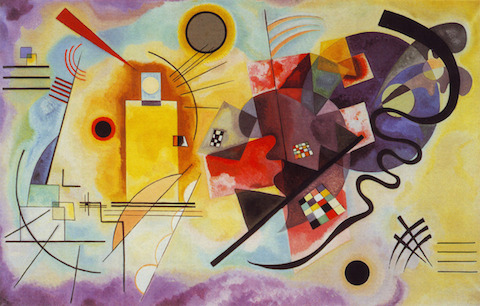
As you faithful readers of Open Culture know, we love nothing more than when important works of humankind fall into the public domain. According to current United States copyright law, a work stays out of the public domain for 70 years after its author’s death; for corporate “works-for-hire,” 95 years after its publication. This means that, theoretically, new things arrive in the public domain each and every year. Since we’ve just started a new one, what has the public domain gained?
On January 1, 2015, according to Duke University’s Center for the Study of the Public Domain, public-domain readers received “the writings of Rachel Carlson, Ian Fleming, and Flannery O’Connor” — in Canada, that is. As for Europeans, they can now freely enjoy “the works of Antoine de Saint-Exupéry, Wassily Kandinsky, Piet Mondrian, Edvard Munch, and hundreds of others.” But what of the Americans? Alas, “no published works will enter our public domain until 2019,” owing to an extension of U.S. copyright law legislation that pushed up retroactive copyright by 95 years for anything created between 1923 and 1977 — a legal event that may, some whisper, have had the endorsement of a certain corporation in possession of a certain highly lucrative cartoon mouse.

For a sense of what this has cost us, the CSPD has put together a tantalizing list of still-vital works of literature, film, music, and science that could have gone public domain this year, if not for that meddling extension. It includes Chinua Achebe’s Things Fall Apart, Simone de Beauvoir’ Mémoires d’une jeune fille rangée, Graham Greene’s Our Man in Havana, Orson Welles’ Touch of Evil, Jacques Tati’s Mon Oncle, Nathan H. Juran’s Attack of the 50-Foot Woman, Chuck Berry’s “Johnny B. Goode,” Sheb Wooley’s “Purple People Eater.”
To learn more about the art that some parts of the world have newly welcomed into the public domain, see also Hyperallergic’s Public Domain Day post by Allison Meier. Though we could easily feel frustrated by the richness of the material that America has refused, in the words of Justice Louis Brandeis, to let “free as the air to common use,” do remember the existence of a little something we citizens of 2015 like to call the internet. The increasingly few boundaries and little friction with which it has enabled us to connect and communicate will certainly continue to alleviate the cramp regulations like these have put in our style. So even if Americans won’t enjoy a meaningful Public Domain Day for four years yet, I’d say we still have reason to celebrate.
via Hyperallergic
Related Content:
Sherlock Holmes Is Now in the Public Domain, Declares US Judge
A Cabinet of Curiosities: Discover The Public Domain Review’s New Book of Essays
Colin Marshall hosts and produces Notebook on Cities and Culture and writes essays on cities, language, Asia, and men’s style. He’s at work on a book about Los Angeles, A Los Angeles Primer. Follow him on Twitter at @colinmarshall or on Facebook.


Thank you Mr. Marshall and OU. I shall, as always, forward this issue of OU out to my son — a lecturer at Algonquin College, Ontario. I’m hoping that he can use OU’s bibliography to enhance his lectures.
I have some work on Cafepress.. and they are removing Kandinsky out from my shop. They send me this letter:
The Artists Rights Society (www.arsny.com) provided us with notice stating that the use of the artwork of “Kandinsky” infridges upon their intellectual property rights (copyright). I apologize for the inconvenience this may have caused you.
The Artists Rights Society now own Kandinsky’s work. Wow.. this is fresh.
Any thought on your part? Thanks for your article.